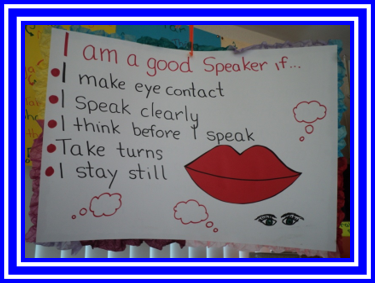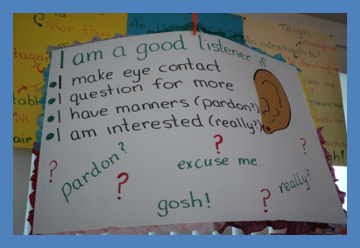The physical environment of a classroom has great power over the quality and the quantity of children’s experiences of oral language (Roskos & Neuman, 2002). Children use print available to them in the classroom and so when creating a rich language environment, be aware that the environment surrounding the pupils meditates the language that they will use.
- Initially, the teacher and the pupils together can discuss the other ways we use to communicate besides words: Non-verbal behaviours[1]
- Use of voice: Use intonation and pauses to convey meaning
- Volume: The voice should be loud enough so the audience can hear the message being delivered. Varying volume helps create emphasis on certain points or when trying to persuade the audience.
- Pitch: Use the rise and fall of the voice
- Pronunciation: Diction, grammar and word usage (no um’s and ah’s)
- Pauses: Used between phrases, ideas or for holding attention
- Eye contact: Eye contact between speakers and audience, not overly dependent on notes
The teacher can record each of these non-verbal behaviours on a card and display in the ‘Speaking and Listening corner’ as a prompt card to remind pupils to use these behaviours. Having it displayed makes it easy to point out and remind pupils how to use their non-verbal behaviours.
- Teacher and pupils can create a poster to capture the mannerisms associated with efficient speaking such as the aforementioned non-verbal behaviours above.

- Teacher and pupils can create a poster to highlight what good listening is.

Possible ideas for ‘Our Speaking & Listening Corner’:
- Monthly feelings chart: Display a poster of different feeling words each month to expand pupils vocabulary. For example, in September, display ‘happy & sad’ vocabulary that you encourage pupils to use in speech and writing.

- Monthly ‘overused words’ chart: Display a poster of different ‘overused’ words each month to expand pupils vocabulary. For example, in September, display ‘said’ vocabulary that you encourage pupils to use in speech and writing.
- Word-of-the-day poster

- Wordwall (e.g. robbery). Or create a word wall display of physical characteristics and appearances vocabulary.

- List of Talk Rules: Involve the pupils in deciding these rules. For added fun, they can sign the poster and so create a ‘Talk Rules Contract’!
- Hang storybooks/ poetry books, books of idioms etc. created by the pupils so they can be re-read.
- Rug area for instruction and whole-group activities
- Speaking and listening posters (see example image above_
- Display list of songs, poems, rhymes learned in class
- ‘Non-verbal behaviours’ prompt card (As mentioned above)
- Games: Stick up prompt cards listing quick oral language games that can be played while waiting to go home etc. E.g. Chinese whispers, Word showers, Simon Says, categorisation games, Alliteration games etc. Change these games each month.
- ‘Speakers’ chair: Use an ordinary chair, decorate and label it.
- ‘Storytellers Hat’: Hat can change from time to time, e.g. Cowboy hat, peaked cap etc.
- Flipchart
- Table
Possible items that can be placed on/ under the table
- Language for Living; Oral Language and Vocabulary Development Box
- Display objects of discussion
- Dress up boxes for role-playing
- Tray of previously learned ‘Words-of-the-day’ handy for revision games
- Listening centre: Working microphone (for recording)/ handheld Dictaphones, CD player, CD’s and headphones
- Toy telephones x2 and message pads (for telephone scenarios and taking messages, role-play etc.)
- Puppets
- Tray of illustrated idioms that were previously learned
- Tray of illustrated tongue twisters that were previously learned
- Class dictionary
- Box of magazines (can be used for picture games, looking at persuasive language etc.)
- Box of newspaper headlines: Pupils can choose a headline and create news report to suit it. These can be used over and over again. Develops questioning skills.
- Book with short stories/ poems
- Tray of Readers Theatre Scripts (many good websites provide these free)
These are just some possible ideas. Have fun creating your ‘Speaking and Listening Corner’ and remember to involve the pupils!
[1] 5 Componente of Effective Oral Language Instruction, Professional Development Service for teachers. Pg. 5 & 6

great resources!
LikeLiked by 1 person
Thanks Julie!
LikeLike